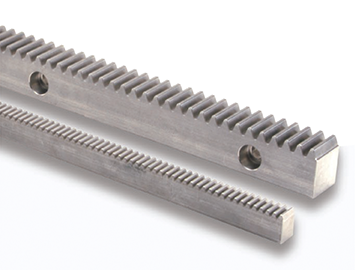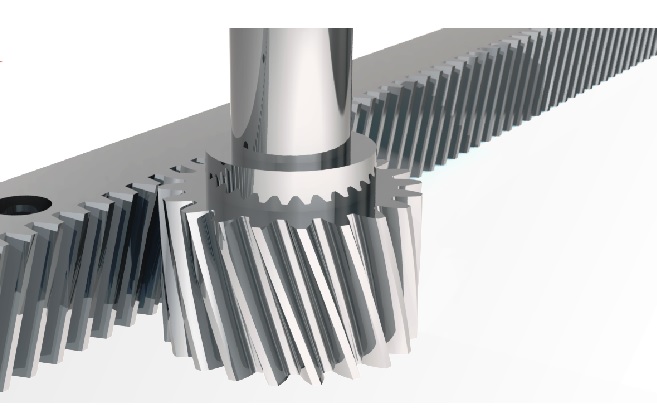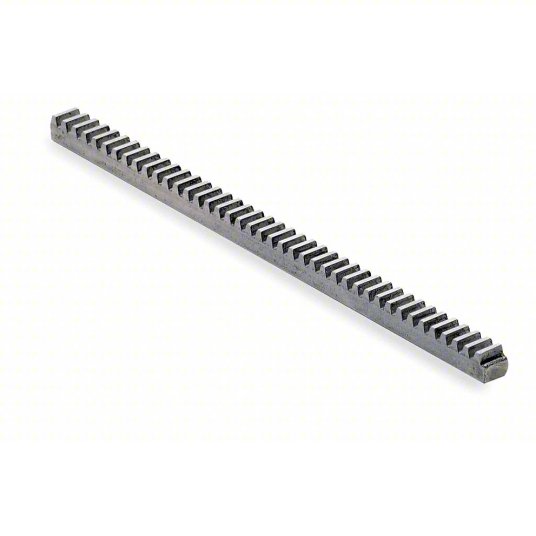Product Description
Spur Gear Rack Great Quality Ground Linear Flexible Industrial Manufacturer Stainless Steel Helical Spur POM Plastic and Pinion Steering Metric pinion Gear Rack
spur gear rack
Material: carbon steel such as C45, 20CrMnTi, 40Cr, 42CrMo or stainless steel or copper or nylon and so on
Heat Treatment: Hardening and Tempering, High Frequency Quenching, Carburizing Quenching and so on.
Standard: European or American standard
Item: M0.5,M1,M1.5,M1.7,M2,M2.5,M3,M4,M5,M6 and so on
Export Area: Europe and America
OEM service: make based on your special sample or drawing and meet your need for high precision on teeth of gear
The rack is a special gear with teeth distributed on the strip body. The racks are also divided into straight racks and helical racks, which are paired with spur gears and helical gears, respectively; the tooth profile of racks is straight rather than involute (it is flat for tooth surfaces) The equivalent of the circle radius of the inHangZhou cylinder is infinite.
The quality character of EP gear racks:
1. Stable transmission and low noise;
2. Effectively avoid normal tolerance based on high precision;
3. The surfaces can be ground to grade 7 quality, and teeth can be ground to grade 6 quality;
4. The mounting holes can be made as request;
5. The price is competitive even the quality is high.
| Type: | Gear Rack |
|---|---|
| Certification: | CE, ISO9001: 2000 |
| Condition: | New |
| Warranty: | 1.5 Years |
| Processing: | Hobbing |
| Color: | as Request |
| Samples: |
US$ 9999/Piece
1 Piece(Min.Order) | |
|---|

Can metric gear racks be customized for specific machinery and equipment?
Yes, metric gear racks can be customized to meet the specific requirements of machinery and equipment. Here’s a detailed explanation of the customization options available for metric gear racks:
Metric gear racks offer versatility and flexibility in their design and can be customized in various ways to suit specific applications. Some of the customization options include:
1. Length and Dimension: Gear racks can be customized in terms of their length and overall dimensions. The length of the gear rack can be tailored to match the required stroke or travel distance of the linear motion system. Additionally, the height, width, and thickness of the gear rack can be adjusted to fit within the available space and meet the specific clearance requirements of the machinery or equipment.
2. Tooth Profile: The tooth profile of the gear rack can be customized to optimize its performance for specific applications. The tooth profile determines the engagement characteristics with the mating gears or pinions. Common tooth profiles include straight (rectangular), helical, and circular arc. The selection of the appropriate tooth profile depends on factors such as load distribution, noise reduction, and smoothness of operation.
3. Material Selection: Gear racks can be customized by selecting the appropriate material based on the application requirements. Different materials, such as steel alloys or other high-strength materials, can be chosen to enhance the gear rack’s load-carrying capacity, durability, and resistance to wear and corrosion. The material selection can be tailored to suit specific environmental conditions, such as high temperature or corrosive environments.
4. Mounting Options: Customization of gear racks can include the provision of specific mounting options. Gear racks can be designed with pre-drilled holes or slots to facilitate easy installation and integration into the machinery or equipment. Custom mounting options ensure proper alignment and secure attachment of the gear rack, enabling smooth and reliable operation.
5. Coatings and Surface Treatments: Gear racks can be customized with various coatings and surface treatments to enhance their performance and longevity. For example, coatings like zinc plating or black oxide can provide corrosion resistance, while surface treatments such as grinding or polishing can improve the gear rack’s surface finish and reduce friction. Custom coatings and treatments can be applied based on the specific environmental and operational requirements of the application.
6. Special Features: Depending on the machinery or equipment’s unique needs, gear racks can be customized with special features or modifications. This may include adding additional features like sensor mounting brackets, position indicators, or integrated lubrication systems. Customized features ensure seamless integration and enhance the overall functionality of the gear rack within the specific application.
It is important to note that the extent of customization options may vary depending on the manufacturer and specific gear rack supplier. Collaborating with experienced gear rack manufacturers or suppliers is crucial to ensure that the customization requirements are met effectively.
In summary, metric gear racks can be customized for specific machinery and equipment by adjusting their length and dimensions, selecting the appropriate tooth profile and material, providing custom mounting options, applying coatings and surface treatments, and incorporating special features. Customized gear racks enable optimal integration and performance within the specific application, enhancing the overall efficiency and functionality of the machinery or equipment.

Can metric gear racks be applied in CNC machining for positioning?
Yes, metric gear racks can be effectively applied in CNC (Computer Numerical Control) machining for precise positioning. Here’s a detailed explanation of how metric gear racks can be used in CNC machining:
1. Precision Positioning: CNC machining requires precise positioning of the cutting tool or workpiece to achieve accurate machining operations. Metric gear racks, when combined with compatible mating gears and a motor, provide a reliable method for converting rotary motion into linear motion. By incorporating a gear rack system into the CNC machine’s axis, such as the X, Y, or Z axis, precise and repeatable linear motion can be achieved. The toothed engagement between the gear rack and the mating gear ensures accurate positioning, enabling the CNC machine to move the cutting tool or workpiece to the desired location with high precision.
2. High Load Capacity: CNC machining often involves handling substantial loads, including the cutting forces exerted on the tool and the weight of the workpiece. Metric gear racks are designed to handle high loads, making them suitable for CNC machining applications. The rack’s robust construction, combined with its ability to distribute loads along the entire length of the rack, ensures efficient power transmission and reliable load handling capabilities. This allows the gear rack system to withstand the forces involved in CNC machining without compromising precision or performance.
3. Longitudinal and Transverse Motion: CNC machines typically have multiple axes of movement to perform various machining operations. Metric gear racks can be applied to both longitudinal (X-axis) and transverse (Y-axis) motion in CNC machining. The gear rack systems can be integrated with linear guides and bearings to provide smooth and precise linear motion along these axes, facilitating accurate positioning of the cutting tool or workpiece in multiple directions. By using gear racks, CNC machines can achieve synchronized and coordinated motion control across different axes, enabling complex machining operations with high accuracy.
4. Backlash Compensation: Backlash, which refers to the slight clearance between the gear rack and mating gear, can introduce positional errors and affect precision in CNC machining. However, metric gear racks can incorporate backlash compensation techniques to minimize the effects of backlash. By utilizing pre-loaded systems or employing gear racks with high tooth engagement ratios, CNC machines can reduce backlash and achieve improved precision in positioning. This ensures that the CNC machine accurately follows the programmed toolpath, resulting in precise machining operations.
5. Compatibility with CNC Systems: Metric gear racks can be seamlessly integrated with CNC control systems and other components commonly used in CNC machines. The gear rack system can be coupled with CNC motors, encoders, and feedback systems to create a comprehensive and synchronized motion control solution. This compatibility allows for precise and coordinated positioning control, ensuring that the CNC machine accurately follows the programmed toolpath and achieves the desired machining results.
6. Customizability and Flexibility: Metric gear racks offer flexibility and customization options to suit different CNC machining applications. They are available in various sizes, modules, and materials, allowing engineers to select gear racks that meet the specific requirements of the CNC machine. Customizable features include tooth profile design, load capacity, and dimensional specifications. This flexibility enables the optimization of gear rack selection based on factors such as load, speed, precision, and environmental conditions, ensuring optimal performance in CNC machining applications.
7. Reliability and Durability: CNC machines are often subjected to continuous operation and demanding machining conditions. Metric gear racks are designed to offer high reliability and durability, ensuring long service life and minimal downtime. The use of high-quality materials, precision manufacturing processes, and proper lubrication contributes to the gear racks’ ability to withstand heavy loads, repetitive motion, and challenging operating conditions. This reliability and durability make gear racks a suitable choice for CNC machining applications.
In summary, metric gear racks can be effectively applied in CNC machining for precise positioning. Their ability to provide precise linear motion, handle high loads, compensate for backlash, compatibility with CNC systems, customizability, and reliability make gear racks a suitable choice for achieving accurate and repeatable motion control in CNC machines. By incorporating gear racks into CNC machining systems, manufacturers can enhance the precision and performance of their machining operations, resulting in high-quality finished products.

What are the primary components and design features of a metric gear rack?
A metric gear rack consists of several primary components and incorporates specific design features to ensure its functionality and compatibility within gear systems. Here’s a detailed explanation of the primary components and design features of a metric gear rack:
1. Base Material: A metric gear rack is typically made from a sturdy and durable material, such as alloy steel, stainless steel, or engineering plastics. The selection of the base material depends on factors like the application requirements, load capacity, and environmental conditions. The base material should possess sufficient strength, wear resistance, and dimensional stability to withstand the forces and wear associated with gear engagement.
2. Tooth Profile: Metric gear racks feature a straight-sided tooth profile known as the involute profile. The involute shape allows for smooth and efficient engagement with mating gears or pinions. The tooth profile is designed based on the module system, where the module represents the size of the gear teeth. The module determines the tooth dimensions, including tooth height, tooth width, and tooth spacing, ensuring compatibility and proper meshing with mating gears or pinions.
3. Module Size: The module size is a critical design feature of a metric gear rack. It represents the size of the gear teeth and is defined as the ratio of the reference diameter to the number of teeth. The module size determines the tooth dimensions, such as the tooth height, tooth width, and tooth spacing. It plays a vital role in ensuring the proper engagement and meshing of the gear rack with mating gears or pinions, as well as determining the pitch of the gear rack.
4. Teeth: The primary feature of a metric gear rack is its teeth, which are evenly spaced along the length of the rack. The teeth engage with the mating gear or pinion to convert rotary motion into linear motion or vice versa. The teeth are precisely machined to ensure accurate tooth profiles and tight tolerances, allowing for smooth and efficient meshing with the mating gear or pinion. The tooth geometry and spacing are designed to minimize backlash and ensure precise positioning control.
5. Mounting Holes: Metric gear racks often include mounting holes along their length. These holes allow for easy attachment and secure mounting of the gear rack to the machinery or equipment. The mounting holes are strategically placed to ensure proper alignment and stability of the gear rack during operation. They facilitate the integration of the gear rack into the overall mechanical system and enable precise positioning and alignment of the rack within the machinery.
6. Surface Treatment: To enhance durability and corrosion resistance, metric gear racks may undergo surface treatments. Common surface treatments include heat treatment, such as carburizing or induction hardening, to increase hardness and wear resistance. Additionally, gear racks may undergo coating processes like nitriding or coating with materials like black oxide or zinc plating to provide additional protection against wear, friction, and corrosion.
7. Standardization: Metric gear racks are designed to conform to specific standards, ensuring compatibility and interchangeability with mating gears or pinions. Common standards include DIN (Deutsches Institut für Normung) and ISO (International Organization for Standardization) standards, which define the tooth profiles, dimensions, and tolerances of metric gear racks. Standardization allows for easy integration and replacement of gear rack components from different manufacturers.
These primary components and design features of a metric gear rack are carefully considered to ensure proper functionality, compatibility, and reliability within gear systems. The materials, tooth profile, module size, teeth design, mounting holes, surface treatment, and adherence to standards collectively contribute to the performance and longevity of metric gear racks in various machinery and mechanical applications.


editor by CX 2023-11-14